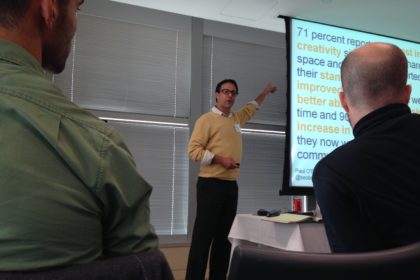
I recently had the honor of sharing the stage with Austin’s elite in the coworking community. Texas State University’s Spectrum program asked Kerry Rupp, CEO of DreamIt Ventures; Brandon Marker, Managing Director of Tech Stars Austin; Kevin Koym, Co-Founder of Tech Ranch; Ryan Field, Research and Information Manager at ATI; Stephen Frayser, Executive Director of STAR Park; Kris Looney, President of Emergent Technologies; Alex Smith, Longhorn Startup and Capital Factory Mentor; and Brian Schoenbaum, Founder and Creative Director at Vuka, to join me in distinguishing the differences between the nearly 25 startup resources that now serve the Austin area.
More than that esteemed panel, I, and nearly 125 entrepreneurs, was joined by Dai Truong of OpenIncubate, Shari Wynne from The Incubation Station, and Claire England with Startup America and RISE. Could you have asked for a better slice of a community, one of the most entrepreneurial communities in America? Not enough juice in one room? Ted Shrader and Jonathan Libby of Austin’s IBM Innovation Center were gracious enough to sponsor the event and host us at their incredible space.
But enough about the panel, you can read more about the premise that led to our discussion here. This is the second time I’ve had the honor of joining Dick Johnson, Donna Taylor, Peggy Richmond, Mike Breck and their nearly philanthropic team. In the past, we’ve discussed the role of team and culture in the success of your venture; this time, I shared the opening remarks, which we’ll review herein, exploring how the way we work is evolving.
Article Highlights
The Role of Coworking Spaces, Incubators, and Accelerators
Of course,this post won’t do our talk justice but I’ll attempt to walk you through the slides here. To keep the conversation going, please, share any questions or thoughts in the comments below.
The Way We Work is EvolvingI love this idea, and I want you to simply plant it in your head as such as this isn’t a talk of how work is evolving but of how our demands, as individuals, are constantly forcing the ecosystem of work to evolve. To wrap your head around this idea, I want you to think of the Galapagos Islands and how that community, isolated from the world, evolved in unique ways to address the resources and demands of life there. The same is true of how and where we work, and it’s true of the community in which you work. If we look at the environment of an office over the last couple hundred years, big picture, we can see this happening. |
We’ve evolved from the Industrial Revolution, and awful work conditions that though were created to fill the demands and needs of the era. As companies replaced sole propretorships (think back further to how everyone use to work for themselves – as boot makers, accountants, bar owners, etc.), and technology changed the need for labor on farms, industry put people to work and though the conditions were poor, it was an evolution out of necessity as the alternative to working in such conditions was often far worse.
I’ve talked about this before, in an exploration of the “Dark Ages of Work.” As people gained wealth and power, industry evolved into company. People demanded better working conditions and unions emerged, wage disparities started to close and it was no longer acceptable to put children to work. We evolved and for a time, that new work environment was celebrated.
The company was replaced by the corporation and like rats in a maze we moved into gray cubes. Cost, equality, productivity, and ergonomics became the name of the game; improvements all, though we look back on it with disdain, because they were in fact an evolution from what preceded.
 To understand where we’re going, think now about how these conditions changed. Many would cite capitalism and our constant drive to further commercialize and monetize business. I want you instead to put yourself in each of those environments and think of yourself as one of Darwin’s Finches. While there are many factors that drive the evolution of work environments (costs, technology, opportunity), etc. at the heart of the evolution is the individual, you; who at each stage, demands something better. Like the finches of the Galapagos, you evolved to suit your environment but unlike finches, when you evolve, you have the capacity to demand better. We, entrepreneurs, force the evolution of how we work by demanding better. By seeing gaps and problems with the environment in which we work, and inventing the new experience.
To understand where we’re going, think now about how these conditions changed. Many would cite capitalism and our constant drive to further commercialize and monetize business. I want you instead to put yourself in each of those environments and think of yourself as one of Darwin’s Finches. While there are many factors that drive the evolution of work environments (costs, technology, opportunity), etc. at the heart of the evolution is the individual, you; who at each stage, demands something better. Like the finches of the Galapagos, you evolved to suit your environment but unlike finches, when you evolve, you have the capacity to demand better. We, entrepreneurs, force the evolution of how we work by demanding better. By seeing gaps and problems with the environment in which we work, and inventing the new experience.
And no where is that more evident than the emergence of coworking. The first of the three environments we’ll explore further.
If you look at an architectural layout of work environments over the years, you see evidence of how each era affected the environment in which we worked. From the controled and structured layout of industry to the jam packed space in which efficiency was favored in the company, we evolved. From that the corporation restored some structure with cube farms, but it also created open environments and campuses on which companies could thrive. My personal startup mythology is born of that experience, my first job was at a little startup called Yahoo; my experience working with entrepreneurs bore witness to sleeping bags under our cubes next to refridgerators stocked with beer. From that environment of the late eighties and early nineties, we’ve evolved; look next at today’s coworking-like layout, open, accessible, fluid, flexible… exactly how we want to work, no?
To appreciate why I’m proposing that we, the entrepreneurs, are at the heart of this evolution, we have to put ourselves in the mind of all entrepreneurs. By 2020, less than 10 years from now, MBO Partners forcasts that 60% of the workforce in the United States will be “unteathered” to a corporate office. Today, only 30% of people working are unteathered. Imagine that… in 7 years, the amount of people working in places OTHER than a company office is going to double. Why? oDesk asked in a survey earlier this year: 72% of job holders in companies have a desire to be independant. Evolution. Or Revolution?
If those trends are an indicator of where our global economy is going, a glimpse at the trends for coworking reveal from where this evolution is being driven. 3 years ago, I moved from Silicon Valley to Austin, TX, not fully realizing the potential that Austin holds for the future of entrepreneurship, innovation, and our economy, but now I’m thrilled by the prospect that the evolution in the way people want to work is gaining the most ground, here in Austin. Evidence of that, in the last 30 days, I’ve had 27 conversations with independant investors, commercial property owners and brokers, incubators, national startup accelerators, economic development professionals, and more, exploring one simple question: what’s next in Austin?
71 percent reported a boost in creativity since joining a shared work space and 62 percent reported that their standard of work had improved. Also 64 percent were better able to complete tasks on time and 90 percent reported an increase in self-confidence because they now worked in a supportive community.
And it’s not hard to appereciate why that’s the case when you read that conclusion of a survey of coworkers by Deskmag’s, that’s their interpretation of the results of the survey, the benefits of coworking. It sounds very much like the very definition of what it’s like to work in Austin doesn’t it?? Creativity. Improved standard of work. Better able to work efficiently. And a focus on the people, you; in this case, our self confidence, professionally. Austin is the very definition of the future work because it reflects what’s at the very heart of what entrepreneurs want.
Evidence of that demand to understand what’s going on in Austin and how to be a part of what’s next, is the trend for coworking relative to office space. Let’s explore not just the idea of coworking now, collaborative work environments that encompass the multitude of incubators, accelators, and coworking spaces; when we look just at the demand for coworking space relative to office space, we see that the indexed demand for office space had been cut in half, more so, over the past five years. Developers and property owners considering more office space should take note: your business model is dying. And though relatively small, the demand for coworking space is still nacent; that demand has been doubling every year for going on a decade.
The challenge for entrepeneurs, the challenge for cities, the challenge for those working in economic development, politics, or human resources, is NOT in being aware of these places. It’s the very reason we gathered for this discussion; the challenge is in knowing which place is right for you.
Where matters more than IF you get into an Accelerator
By the time you read this, this list of known spaces in Austin alone, will undoubtedly have changed: Workshop Hyde Park, Capital Factory, Open Incuabate, Incubation Station, Posh, Emergent Technologies, STAR Park, Link Coworking, Conjunctured, DreamIt Ventures, Perch, IC2, Space12, Tech Ranch, Longhorn Startup, ATI, Techstars, GoLab, Opportunity SPace, Make+Shift, Soma Vida, Chicon Collective, HubAustin, Brainstorm Coworking, and Center61. Which of you has time to figure out wherein you should fit? Which of you, with limited resources and time, can investigate dozens of opportunities and find the right experience for you?
The initial Boston operation of Y Combinator was closed, out of frustration with New England’s typical investment style; making it difficult for Y Combinator’s consumer, web-based ventures to to receive funding. Where, is more important than if, you get into such an experience as the culture, ecosystem, passion, and program therein is what determines the impact such spaces have on your success.
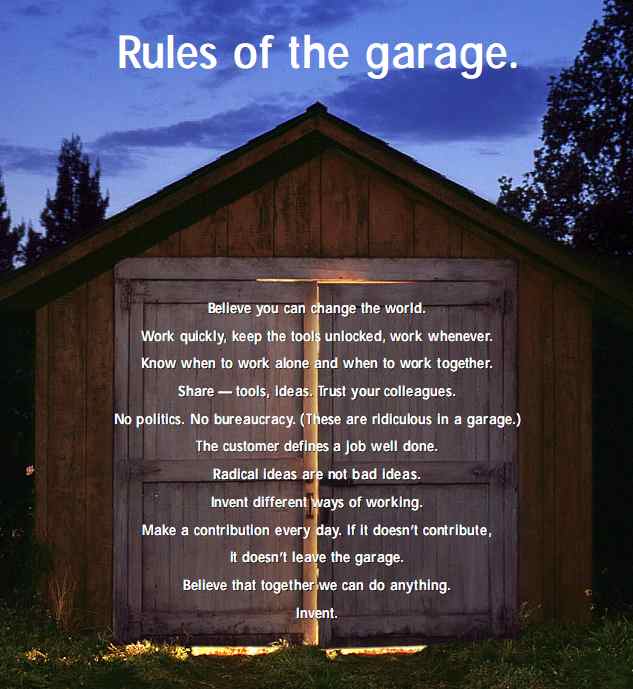 My career with Yahoo led to another technology startup, a somewhat larger venture called Hewlett-Packard. Therein, my perspective on the evolution of how we work was shaped even further. Most aren’t familiar with this garage, it’s the garage in which David Packard and Bill Hewlett built an audio oscillator, an electronic test instrument used by sound engineers. In the moment HP was born, so too was this bit of startup mythology in my ethos, the garage in founders toil away at any cost to bring their dreams to life. And though my career started with Yahoo, the “Rules of the Garage,” ideals at the heart of HP, continue to define who I am as an entrepreneur to this very day: Believe you can change the world.
My career with Yahoo led to another technology startup, a somewhat larger venture called Hewlett-Packard. Therein, my perspective on the evolution of how we work was shaped even further. Most aren’t familiar with this garage, it’s the garage in which David Packard and Bill Hewlett built an audio oscillator, an electronic test instrument used by sound engineers. In the moment HP was born, so too was this bit of startup mythology in my ethos, the garage in founders toil away at any cost to bring their dreams to life. And though my career started with Yahoo, the “Rules of the Garage,” ideals at the heart of HP, continue to define who I am as an entrepreneur to this very day: Believe you can change the world.
Coworking, this revolution of how we work, is the startup garage of the future. We’ll look back in 10 or 15 years at today, and your startup mythology will hearken back to the names DreamIt, ATI, and Vuka. Where once startups were born of garages, apartments, and cramped offices, now they are born of coworking environments. Proof of that? 87% of people working in such environments affirm that they have started something with someone they met through coworking.
So what is coworking anyay??
Coworking is a style of work that involves a shared working environment, often an office, and independent activity. Individuals are usually not employed by the same organization.
Coworking enables a group of people who share values, and who are interested in the synergy that can happen from working with like-minded, talented people, in the same space.
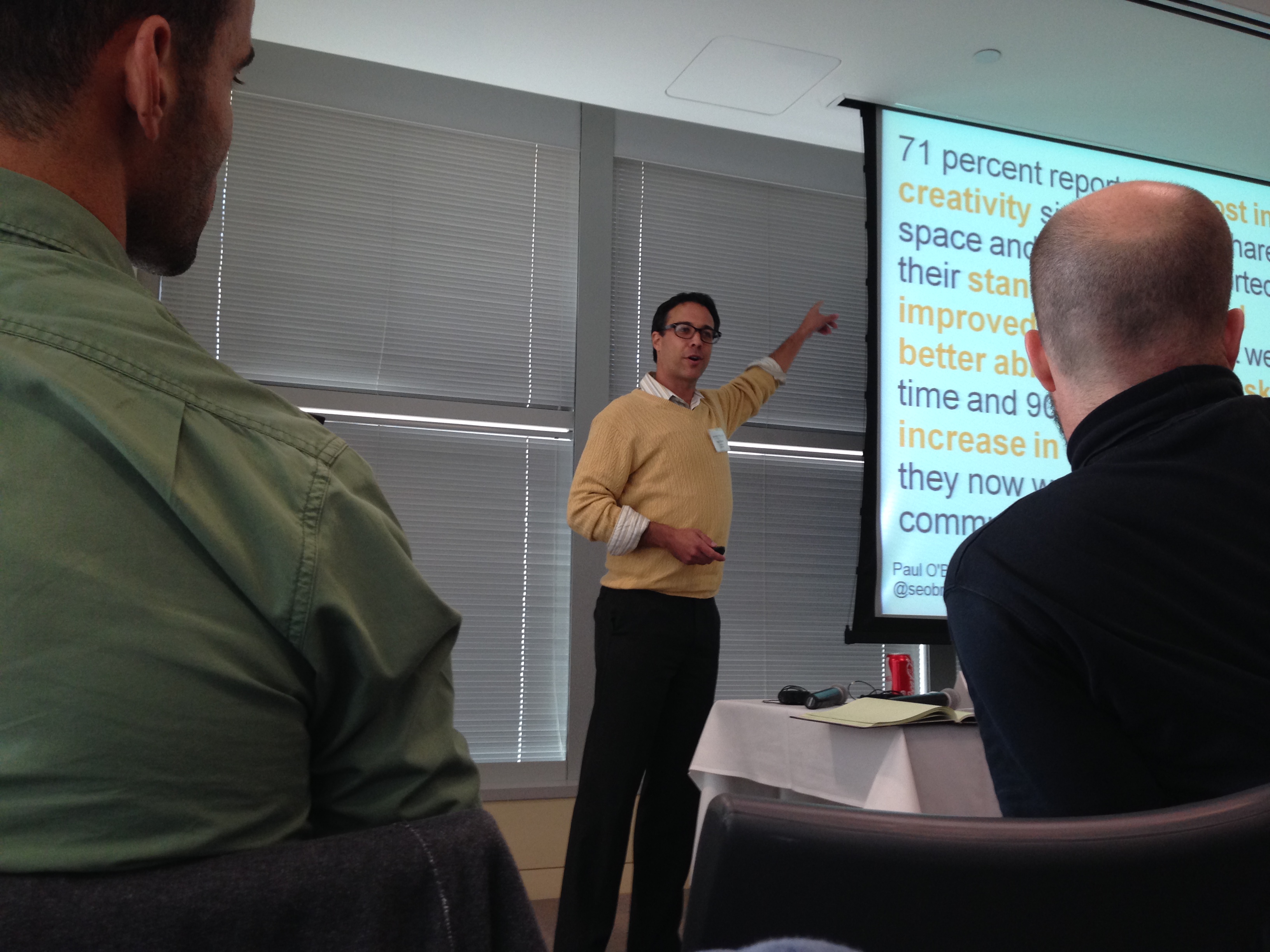 And people are not simply starting things in coworking spaces. To those of you who think you or your team can’t work from a coworking space because of all the distractions, the open environment, consider this… people working in coworking environments have reported a 38% increase in their income, a 75% increase in their productivity, and an 80% increase in their business network. How can you not help force the next evolution and move in?
And people are not simply starting things in coworking spaces. To those of you who think you or your team can’t work from a coworking space because of all the distractions, the open environment, consider this… people working in coworking environments have reported a 38% increase in their income, a 75% increase in their productivity, and an 80% increase in their business network. How can you not help force the next evolution and move in?
What Makes an Incubator Different?
Good question. I’m glad you asked, it’s why we’re here. Incubators accelerate the successful development of startup and fledgling companies by providing entrepreneurs with an array of targeted resources and services. Oof, that’s a mouthful. Think of it this way, incubators provide more structured and vetted resources than space alone, in exchange for a share of your success.
Incubators generally, and I’m going to get disagreement on this as they are ALL different, but generally:
- Provide a principal mentor / coworking space do not
- Develop and manage various services
- Help you network with, and perhaps even fund, other skilled professionals
- Provide space and low or usually no cost
- Can help you find working or seed capital
The opportunity for you is that Incubators are usually free but share in your success by taking a size-able share of the equity available. Coworking spaces are merely an iteration of office space and therefore, certainly, cost you rent. If you can get into an incubator make sure you appreciate the costs as that equity can be significant BUT you benefit from formal education programs, vetted mentors, trusted networks, and supportive staff. That’s not to say the same can’t be found too at a coworking space, but again, generally, that’s the difference.
A simple way to think about how to find WHERE you belong? Incubators usually align along economic development goals related to an industry; they search Health, Wireless, Bio-science, Internet, Small Business, etc. By contrast, when searching for the right coworking space, you’re going to want to focus on the right culture, the right feel; it’s a community.
How is an Accelerator Different from an Incubator?
According to Paul Bricault, cofounder of LA’s Amplify Accelerator, “An accelerator takes single-digit chunks of equity in externally developed ideas in return for small amounts of capital and mentorship. They’re generally truncated into a three to four month program at the end of which the start-ups ‘graduate'”
Simple right?
- Accelerators usually provide many mentors
- Rather than services offered, they tend to have a formal program you have to follow
- Resources are again available, vetted and often funded by the accelerator on your behalf
- Space should be available to you at very low or no cost
- In this case though, capital should be invested by the accelerator in the work you’re doing
The differences are subtle but they are there. You might think of an accelerator as being appropriate at a state later than wherein you might consider an incubator. Because they are investing, they should expect some measure of traction: a product, customers, partners, etc. They aren’t incubating your business but accelerating it’s growth.
As a result, the commitment, by both parties, is greater. They’ve invested in you at a later stage, so generally the equity stake they have is smaller than that of an incubator, but in exchange for that investment, you are required to participate in their 3-6 month program designed to accelerate an aspect of your business. Hence the somewhat later stage.
A favorite perspective of mine is that of Dr. John Sullivan, Professor of Talent Management at San Francisco State University. Sullivan helped me understand that the usual suspects that different cities cite in trying to explain why Silicon Valley results in such significant companies born of seemingly crazy ideas, things like capital, comfort with risk, talent, etc., those suspects are all misleading when trying to appreciate what makes Silicon Valley tick. He shared:
“If you don’t live in the Silicon Valley, you might not know why so many successful firms like Facebook, Google, Twitter, and Apple start or relocate here. The compelling reason is because of the energy and the competition that exists when so many smart and innovative people work and interact in a relatively small geographic space… Obviously having so many great firms so close together also creates intense wars for talent but that one detrimental factor is more than overcome by the positive value of the competition felt with employees from other firms.
The same can be said for the increased creativity that firms find by locating in major arts and entertainment areas like New York City and Los Angeles. The same increase in innovation and idea-generating can occur using “corporate coworking” when your employees are co-located with strangers from startups and other corporations.”
The highlight therein is my own. Silicon Valley is coworking, on a macro-economic scale: the entire region acts like a incubator, developing and nurturing ideas into business; as an accelerator, funneling entrepreneurs through a “program” of growth; and as a coworking space, with a culture of entrepreneurship and extensive network of services, resources, and experienced professionals.
When trying to understand how and where you fit in to such experiences, ask first what you REALLY need. All entrepreneurs need space, capital, talent, mentorship, & influence, the answer to my question is deeper than that. Start by asking yourself if you have enough of a product or service developed to start talking. At what stage do you find yourself and what kind of resources, services, and community do you need? Next ask if you can be distracted and consider that it’s not the coworking space in which you’ll find distraction, in fact, therein, you’re more likely to be far more productive; rather, it’s the dedicated attention required by an accelerator that will distract you from other opportunity. That might be exactly what you need. I just want you to ask those questions first as getting some working capital, getting some mentors, getting some influence with the press or partners, or simply having some exciting office space, should not be at the root of your exploration of this evolution in the way we work.
Know the differences in the types of resources; know that they are different where you live, from those that are here in Austin,, TX; look at them from a 30,000 foot view, determine WHERE you should be, and move in.

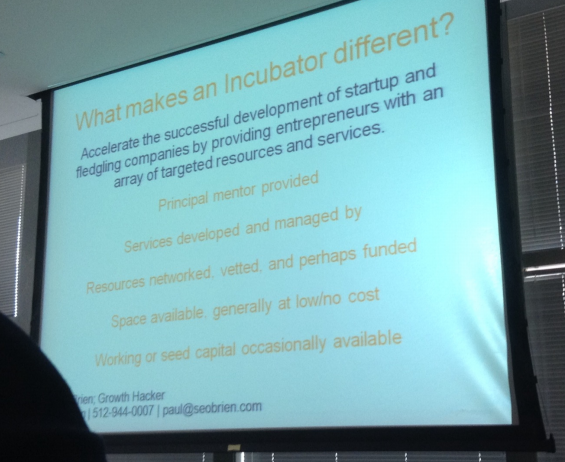
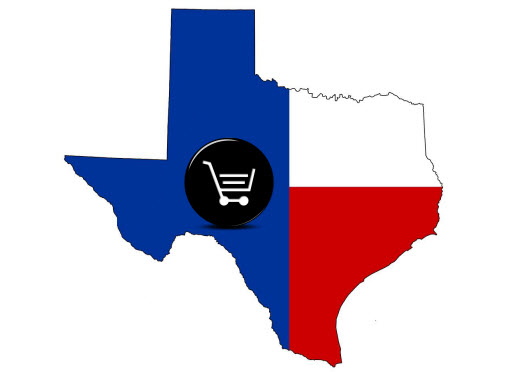
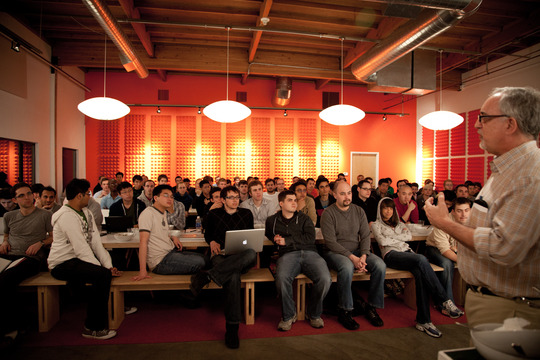
Its interesting because I think just the opposite. I think every engineer should be provided with a dark cave where they can think and be left alone. That’s all I ever wanted and several time smashed the horrific fluorescent lights above. We would have to wait until 7pm when all the sales and marketing chatterbugs went home so we could think and get real work done I can’t imagine trying to get anything done in the new trendy colocation accelerator open happy lands.
While I agree that cube land is dreadful I don’t quite find the ergonomics of sitting at a big open table so great either. What if I have to look up something as an engineer. Will the other engineers notice and think I’m an idiot. Now suddenly I’m terrified of what I do at the computer and cant be productive.
The truth is sooo many of the “accelerator” companies are lost in trendyness of it all, most don’t have sound business plans, and most will fail maybe even more so than the normal failure rate of startups.
A company like co-space would do great if they had really nice private mini offices, and stocked fridges and a couple conference rooms and a receptionist and the ability to leave our corporate branding out front so it seemed like a full on office. That would be perfect. But insted they’ve gone with the trendy lets all sit in the same room. That’s great for market segmentation brand specifiers but hardly the environment a programmer wants to be in.
I was in one incubator once – the womans tech incubator in SF. They left us alone in normal office space and just had a few great talks every now and again. I think that’s a more positive model.
I think most startups dont need so much an incubator as a network-bator, a organization you can join that has public events where some of the industry VC junior partners attend and scout whats going on, a place to help network, that would be the most valuable thing and while I think some accelerators try this its really only a minor part and too often it seems like a mentor-child relationship which is great for the 20 somethings, not so great for those of us on our fifth startup.
Finally, one thing that SF did really well was have nights out at the pub for startups where people just schmoozed. It was every month and well publicized. Austin could use some of that. One big problem Austin has is down-town itis. With the traffic being horrendous all the events are held right in the thick of downtown and yes if you are a 20 something trendy with an apartment on sixth street thats fine, but if you have a house up north battling traffic and time and parking to go all the way downtown is a horror. So Some events should be held up north. I remember when I was working as a cto in san diego so many cool events were held, but they started at 6:30. The best I could ever get anywhere was 8 so I never made it to anything. Time of the events is another thing that’s important if you want to get senior people involved.
@gianna Definitely agree with all three points. I’m a software engineer, and whenever I go to a coworking space, I spend the entire day with my headphones lost in work or in video conferences with actual teammates. What I do like about coworking days is the lunch hour…which is basically a networking event. So you’re spot on about the “network-bator”. I’ll also confess that since I moved up north I rarely attend events in downtown. Traffic, no train service after 6pm, etc.
The future doesn’t look so rosy @seo’brien. It looks more like a corporatist state where large segments of the population are deemed “disposable”. That is, even though corporations are richer than ever, they employ less and less people. So the jobs you describe are for less and less people. And this was a trend that started way before AI came into the scene. What I would love to see is the next generation of entrepreneurs explicitly decide to create companies that don’t treat people like digits on a spreadsheet (B corps, maybe?). That’s the real evolution we need to make.
Thanks for your valuable writing about the concept of coworking space